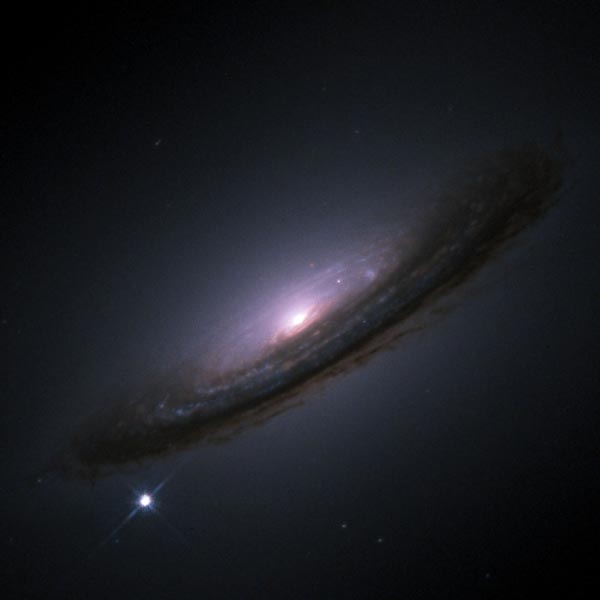Detonating white dwarfs as supernovae

Hubble Space Telescope image of the type Ia supernova 1994D (lower left) in galaxy NGC 4526. Credit: NASA/ESA, the Hubble Key Project Team and the High-Z Supernova Search Team
“Type Ia supernovae are extremely important objects in physics, best known for their role in revealing that the expansion of the universe is accelerating,” said paper co-author Saavik Ford, who is a research associate in the Museum’s Department of Astrophysics as well as a professor at the Borough of Manhattan Community College, City University of New York (CUNY); a faculty member at CUNY’s Graduate Center; and a Kavli Scholar at the Kavli Institute for Theoretical Physics. “The problem is that people do not agree on exactly how Type Ia supernovae come to be.”
Current research indicates that Type Ia supernova explosions originate from binary star systems—two stars orbiting one another—in which at least one star is a white dwarf, the dense remains of a star that was a few times more massive than our Sun. For this study, the scientists investigated how two white dwarfs might form a supernova.
“The simplest way to create a Type Ia supernova is to run two white dwarfs into one another,” Ford said. “In our local universe, there are very few white dwarf binaries that are close enough to collide. Yet we see lots of supernovae lighting up our universe, so we know that something else is probably going on to cause those explosions.”
Ford and co-author Barry McKernan, who is also a research associate in the Museum’s Department of Astrophysics, a professor at the Borough of Manhattan Community College, CUNY, a faculty member at CUNY’s Graduate Center, and a Kavli Scholar at the Kavli Institute for Theoretical Physics, propose the following: White dwarfs are roughly Earth-sized balls of dense, compressed, degenerate matter that wobble, or oscillate.
When two white dwarfs orbit each other they tug on one another, emitting gravitational radiation that takes away energy from their orbit. This causes them to get closer and closer together. During this process, known as inspiraling, the binary orbit of the stars gets smaller, the frequency of the tugging gets stronger and, at certain “sweet spots,” it matches an oscillation frequency in at least one of the white dwarfs. When this happens, a phenomenon called resonance is produced, which can be visualised by a child being pushed in a playground swing.
“Pushing your kid in time with the natural interval, or frequency, of the swing ramps up the energy and gets them higher and higher,” McKernan said. “There’s a similar effect in our model, where a lock on the frequency produces a series of rapid jumps in energy that are deposited into the white dwarfs.”
As a result, if enough energy is deposited in the resonating white dwarf, it could explode before it touches the other one. If the white dwarf does not explode, the resonance causes the orbit to shrink faster than predicted by gravitational wave emission alone, so the stars will crash into each other faster than would normally be expected.
“Basically, we’ve proposed that if you have two white dwarfs spiralling towards each other and you shake one of them the right way for long enough, one will either blow up or you’ll bring the objects closer together faster for an eventual detonation,” McKernan said.
Ford and McKernan plan to test their model by combing through data produced by up-and-coming gravitational wave detectors like eLISA, a space-based observatory expected to launch in 2029.
“If we’re right, eLISA may be able to see glitches in the gravitational waveforms coming from some of the nearest white dwarf binaries,” McKernan said. “That would be amazing to see.”
Further information
Funding for this study was provided by the National Science Foundation grant #s PAARE AST-1153335 and PHY11-25915.
The new work appears in “On the resonant detonation of sub-Chandrasekhar mass white dwarfs during binary inspiral”, B. McKernan and K. E. S. Ford, vol. 463 (2), pp. 2039-2045, Monthly Notices of the Royal Astronomical Society, Oxford University Press. A copy of the paper is available from http://mnras.oxfordjournals.org/content/463/2/2039
- Full bibliographic informationThe new work appears in “On the resonant detonation of sub-Chandrasekhar mass white dwarfs during binary inspiral”, B. McKernan and K. E. S. Ford, vol. 463 (2), pp. 2039-2045, Monthly Notices of the Royal Astronomical Society, Oxford University Press. A copy of the paper is available from http://mnras.oxfordjournals.org/content/463/2/2039
For further information, please contact:
Robert Massey
+44 (0)20 7734 3307
Media Contact
All latest news from the category: Physics and Astronomy
This area deals with the fundamental laws and building blocks of nature and how they interact, the properties and the behavior of matter, and research into space and time and their structures.
innovations-report provides in-depth reports and articles on subjects such as astrophysics, laser technologies, nuclear, quantum, particle and solid-state physics, nanotechnologies, planetary research and findings (Mars, Venus) and developments related to the Hubble Telescope.
Newest articles

NASA: Mystery of life’s handedness deepens
The mystery of why life uses molecules with specific orientations has deepened with a NASA-funded discovery that RNA — a key molecule thought to have potentially held the instructions for…

What are the effects of historic lithium mining on water quality?
Study reveals low levels of common contaminants but high levels of other elements in waters associated with an abandoned lithium mine. Lithium ore and mining waste from a historic lithium…

Quantum-inspired design boosts efficiency of heat-to-electricity conversion
Rice engineers take unconventional route to improving thermophotovoltaic systems. Researchers at Rice University have found a new way to improve a key element of thermophotovoltaic (TPV) systems, which convert heat…



